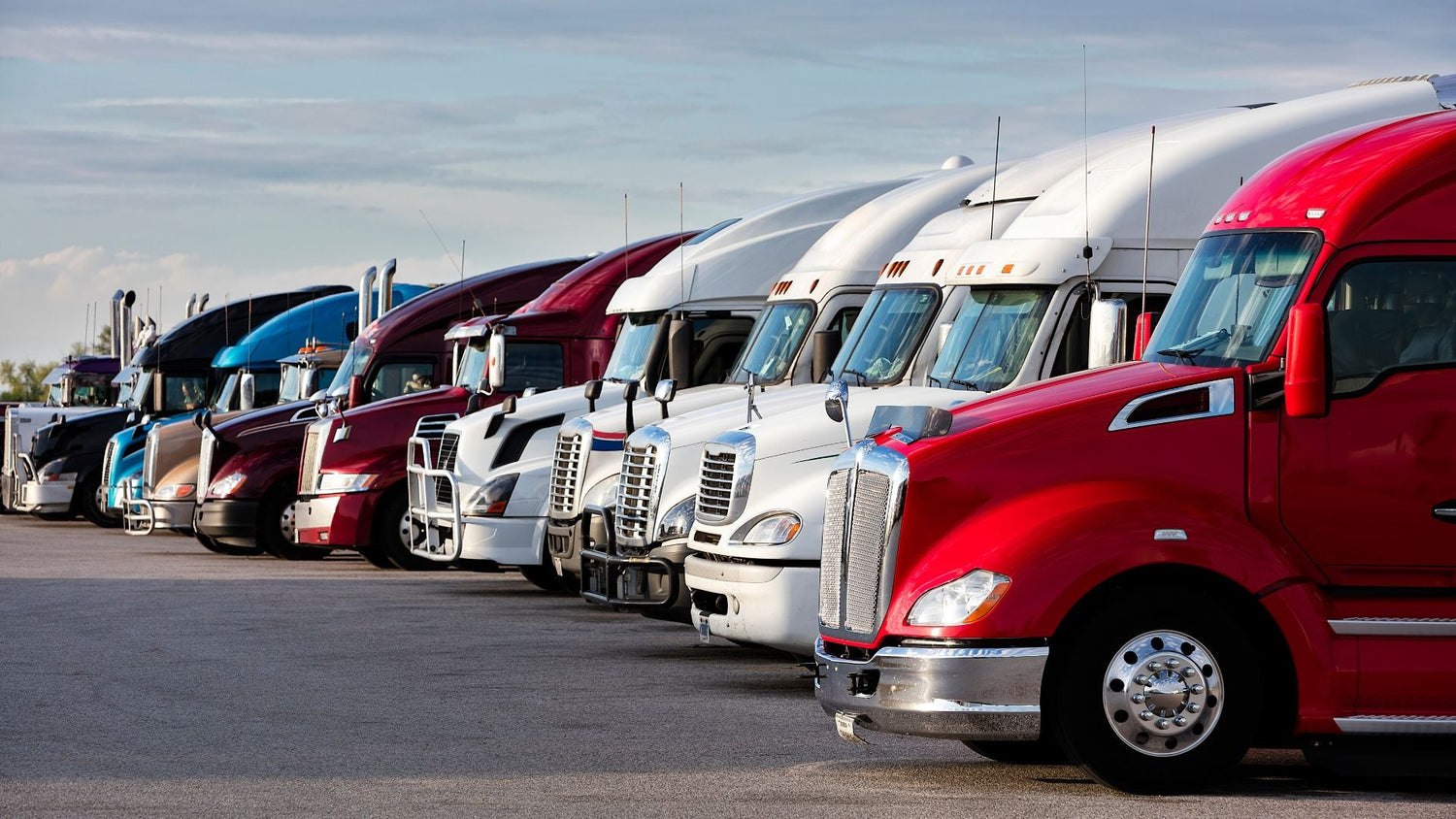The trucking industry in Canada plays a vital role in driving the nation’s economy by ensuring goods are transported efficiently across provinces. As of 2025, the demand for truck drivers remains high due to economic growth and the evolving needs of supply chains. However, the sector faces significant challenges, including labor shortages and increasing expectations for sustainability. These factors are shaping the future landscape of trucking across the country.

To meet these demands, the industry is turning to emerging technologies like automation, telematics, and advanced safety systems. At the same time, sustainability initiatives are gaining traction, with efforts to reduce carbon emissions and transition to eco-friendly practices. These changes are not only enhancing efficiency but also redefining the business strategies of fleet owners who must adapt to remain competitive.
Key Takeaways
- Trucking remains critical to Canada’s economy despite challenges.
- Technology is transforming operations across the trucking sector.
- Sustainability goals are reshaping long-haul transport strategies.
The Current State of Trucking in Canada

The trucking industry in Canada plays a critical role in connecting key provinces, supporting national supply chains, and adhering to stringent safety and regulatory standards. It serves as a backbone to the economy with an intricate system of fleets, hubs, and policies.
Key Provinces and Industry Hubs
Several provinces are central to Canada’s trucking sector. Ontario leads with the largest concentration of trucking companies and fleet operations, thanks to its proximity to major trade routes and border crossings. Alberta is pivotal due to its role in transporting goods from the oil and gas sector, while Manitoba acts as a vital hub connecting central Canada to regions across North America.
Major trucking hubs include cities such as Toronto, Calgary, and Winnipeg. These locations host numerous transport industry businesses and serve as logistics centers for the movement of goods nationwide.
Role in National Supply Chains
The Canadian trucking industry is integral to the country's supply chain, moving essential goods like food, fuel, and construction materials. Trucking accounts for a significant portion of domestic shipping, with the sector responsible for over 90% of all freight transportation within Canada's borders. Fleet owners coordinate daily operations to ensure timely deliveries across thousands of kilometers.
Businesses rely heavily on trucking for imports and exports, especially at border crossings where hundreds of trucks pass each day, connecting Canada to trade partners like the United States.
Present Regulatory and Safety Standards
Canada enforces strict regulatory requirements to ensure the safety of its trucking operations. Drivers must comply with rules surrounding hours of service, vehicle inspections, and load security. Safety standards include mandatory electronic logging devices (ELDs) to track driving hours and reduce fatigue-related risks.
The transport industry is also subject to frequent audits and inspections at provincial and federal levels. Fleet owners are responsible for maintaining vehicles according to these regulations and ensuring drivers are adequately trained.
Emerging Technologies Transforming the Trucking Sector
The trucking industry in Canada is experiencing significant changes due to advancements in technology. Key developments are reshaping operations, emphasizing efficiency, sustainability, and innovation in fleet management and transportation.
Advances in Vehicle Electrification
Electric vehicles (EVs) are transforming fleet operations, offering cleaner energy alternatives and reducing dependence on fossil fuels. Vehicle electrification is particularly important as fleet owners look to comply with stricter emissions regulations. Manufacturers are launching trucks with improved driving ranges, making EV adoption viable for long-haul transportation.
Charging infrastructure is expanding across Canada, addressing concerns about accessibility. Pilot projects are testing fast-charging solutions and energy-efficient battery designs to further support electrification within the trucking sector.
Telematics and Fleet Management Systems
Telematics enhances operations by integrating GPS tracking, real-time monitoring, and comprehensive analytics. Fleet owners use these systems to improve overall efficiency, reduce operational costs, and maintain compliance with regulations.
These systems also support better route planning, enabling trucks to minimize fuel consumption. Tools like electronic logging devices (ELDs) help track driver hours and ensure adherence to safety protocols, streamlining fleet oversight.
Autonomous Driving and Pilot Projects
Autonomous driving technologies are advancing, with pilot projects offering insights into their feasibility. Key systems include adaptive cruise control, collision avoidance, and lane departure warnings, promoting safer driving conditions.
While fully autonomous trucks remain in development, these technologies are being tested across controlled routes in Canada. Fleet owners are closely evaluating their potential to reduce human error and improve transportation efficiency.
Sustainability and Decarbonization Initiatives
Efforts to make trucking in Canada more sustainable focus on reducing greenhouse gas emissions, adopting renewable energy sources, and implementing comprehensive net-zero emissions plans. These initiatives target key areas to lower the carbon footprint of the industry while promoting environmentally friendly practices.
Reducing Greenhouse Gas Emissions
The Canadian trucking sector is employing various strategies to cut greenhouse gas emissions. Programs such as Canada's Action Plan for Clean On-Road Transportation encourage fleet operators to conduct energy assessments and implement fuel-efficient retrofits.
The Canadian Trucking Alliance supports these efforts by advocating for green technologies, smart environmental policies, and fleet upgrades that optimize fuel consumption. These measures significantly contribute to limiting the carbon footprint of on-road transport, enhancing its sustainability.
Transitioning to Renewable Energy Sources
Transitioning trucking to renewable energy sources is a critical step in the decarbonization process. Initiatives like zero-emission vehicle programs, highlighted on Transports Canada, aim to accelerate the adoption of electric and hydrogen-powered trucks.
These vehicles rely on renewable energy to operate, which helps reduce dependence on fossil fuels and curbs carbon emissions. Government incentives and investments encourage companies to modernize their fleets and adopt clean energy solutions.
Net-Zero Emissions Roadmaps
A detailed roadmap is vital to achieving net-zero emissions in Canada's trucking industry. Programs such as the Canada Green Freight Program provide guidance and financial support to help fleets transition to sustainable practices.
This includes both operational changes, such as enhanced route optimization, and larger structural shifts, such as the implementation of zero-emission technologies. These roadmaps align with Canada’s broader climate goals, ensuring that the trucking sector plays a significant role in reducing its overall environmental impact.
Business and Financial Planning for Fleet Owners

Effective financial and business planning is crucial for fleet owners who aim to optimize operations, ensure compliance, and improve profitability. Key strategies include managing taxes, leveraging depreciation, and maintaining accurate records to track expenses and allocate resources effectively.
Tax Planning and Depreciation
Fleet owners can benefit from robust tax planning strategies that help manage liabilities and safeguard cash flow. Depreciation plays a vital role, allowing businesses to gradually account for the wear and tear of vehicles. Using methods like straight-line depreciation can simplify calculations, but accelerated methods might provide greater savings in earlier years, depending on the fleet’s operational needs.
Key Considerations:
- Choose the appropriate depreciation method based on vehicle usage.
- Monitor tax deduction limits for expenses like fuel, maintenance, and insurance.
- Work with a qualified tax expert to maximize deductions and minimize audit risks.
Capital Cost Allowance Strategies
Capital Cost Allowance (CCA) enables fleet owners in Canada to deduct a portion of their vehicle and equipment costs annually. Structuring purchases to align with CCA rates can enhance financial planning. For example, certain classes of vehicles may qualify for higher CCA rates, providing faster relief on upfront costs.
Suggestions for Fleet Owners:
- Group purchases strategically to take advantage of CCA for high-cost assets.
- Track and update asset classifications to comply with evolving tax regulations.
- Stay updated on government initiatives, such as incentives for zero-emission vehicles, which may offer favorable CCA treatments.
Expense Tracking and Bookkeeping
Accurate expense tracking and professional bookkeeping are essential for fleet owners to maintain financial transparency and make informed decisions. Utilizing cloud-based software can streamline the process and reduce errors. Categories such as vehicle repairs, fuel costs, and driver wages must be meticulously recorded to ensure proper allocation.
Tips for Effective Bookkeeping:
- Categorize Expenses: Separate fixed and variable costs to better analyze spending patterns.
- Implement Tech Tools: Adopt platforms like QuickBooks or Xero for automated tracking and real-time reporting.
- Set Regular Reviews: Schedule monthly reconciliations to identify discrepancies early and confirm accuracy.
Sustainable Long-Haul Trucking: Opportunities and Challenges
Developing sustainable solutions for long-haul trucking involves tackling fuel efficiency and embracing new technologies, including electric vehicles. Both challenges and opportunities exist as the trucking sector seeks to reduce its environmental impact and improve overall efficiency.

Improving Fuel Consumption and Efficiency
Fuel consumption remains a critical issue in long-haul trips, as diesel-powered trucks dominate the trucking sector. Optimizing fuel efficiency involves adopting better driving practices, such as using cruise control, reducing idling times, and maintaining steady speeds. Improved aerodynamics and the use of low-resistance tires further contribute to reduced fuel usage.
Enhanced logistics planning also helps minimize empty backhauls, saving fuel by optimizing routes and load distribution. Some fleets are transitioning to biofuels as an interim step to lower emissions while maintaining compatibility with existing diesel engines. These strategies can reduce operational costs while also cutting emissions.
Key Methods to Improve Fuel Efficiency:
| Strategies | Benefits |
|---|---|
| Aerodynamic Designs | Decreased wind resistance |
| Low-Resistance Tires | Reduced rolling friction |
| Biofuels Integration | Lower emissions potential |
Electric and Diesel Vehicle Comparison
Electric vehicles (EVs) present a growing opportunity to reduce emissions in long-haul trucking. Battery electric trucks eliminate tailpipe emissions and may offer lower operating costs than diesel trucks over time. However, challenges remain, like limited charging infrastructure and long battery charging times, which must improve before widespread adoption.
Diesel trucks continue to lead in long-haul trips due to their range and ability to refuel quickly. While they produce higher greenhouse gas emissions, advancements in cleaner diesel technologies aim to reduce their environmental footprint.
Comparison of Electric vs Diesel Long-Haul Vehicles:
| Aspect | Diesel Trucks | Electric Trucks |
|---|---|---|
| Emissions | High greenhouse gas output | Zero tailpipe emissions |
| Range | Extensive | Limited but improving |
| Refueling/Charging Time | Quick refueling (minutes) | Longer charging times (hours) |
| Operating Costs | Fluctuates with fuel prices | Potentially lower over time |
Policymakers and businesses must weigh these factors while working to support a smooth transition to sustainable trucking technologies.
Distribution Networks and the Changing Supply Chain Landscape

The trucking industry plays a critical role in maintaining and evolving Canada's supply chain systems, especially as distribution networks adapt to new economic and consumer realities. These networks rely heavily on efficient transportation to meet shifting demands while balancing cost and sustainability concerns.
How Trucking Supports Modern Distribution
Trucking is the backbone of Canada's distribution network. Road freight transportation accounts for the majority of goods moved within the country, thanks to its flexibility and vast accessibility across urban and rural areas. Trucks connect warehouses, ports, and production facilities, ensuring goods flow seamlessly between key points in the supply chain.
Canada's extensive road network makes trucking the preferred method for transporting goods, particularly heavy cargo. It complements other transportation modes, such as railways and shipping, by offering the last-mile delivery capability that other systems cannot provide.
The sector's importance is underscored by its impact on industries ranging from retail to agriculture, where timely delivery is often crucial. Examples include:
- Retail chains depending on trucking for inventory restocking.
- Farmers utilizing trucks to distribute fresh produce quickly.
Adaptations for Evolving Consumer Demand
Consumer demand in Canada is increasingly shaped by e-commerce growth and a heightened focus on fast delivery times. The rise of online retail has led to a greater need for decentralized distribution centers, allowing trucking companies to reduce delivery times and costs.
To meet these demands, many trucking companies are embracing advanced logistics technologies, such as GPS tracking and route optimization software. These tools enhance efficiency and keep pace with the dynamic needs of modern supply chains. Additionally, there is growing attention to sustainability, with some fleets transitioning to electric or fuel-efficient vehicles to align with climate-conscious consumer expectations.
Key strategies include:
- Shortening delivery timelines through regional distribution hubs.
- Incorporating more environmentally friendly vehicles and practices.
These developments illustrate how trucking is evolving alongside consumer behavior, ensuring its role remains indispensable in Canada's modern supply chain.
Frequently Asked Questions
The trucking industry in Canada is undergoing rapid transformation due to advancements in technology, shifts in policy, and environmental considerations. Key topics include automation, employment trends, and government efforts to address challenges.
What are the emerging trends in the Canadian trucking industry for the coming decade?
Canada's trucking sector is seeing increased adoption of electric and autonomous vehicles, which promise lower operational costs and efficiency improvements. Additionally, the industry is focusing on sustainability and adapting to climate goals. Labor shortages continue to push innovation in workforce strategies.
How are advancements in technology expected to affect trucking in Canada?
Technological innovations are reshaping logistics operations, with automation and data-driven tools enhancing route planning and delivery precision. Electric trucks and vehicle connectivity are reducing dependency on fossil fuels and improving safety standards.
What is the projected outlook for employment in the trucking sector in Canada post-2025?
The demand for truck drivers remains high due to a persistent labor shortage. However, automation may shift job roles, requiring workers to adapt to more technical positions involving the management and maintenance of modernized equipment.
In what ways is the Canadian government addressing challenges within the trucking industry?
Government initiatives include public consultations on transportation-related policies and funding programs to promote clean energy adoption. Efforts also focus on addressing driver shortages and improving safety regulations within the sector.
How might environmental policies impact the trucking industry in Canada?
Stricter environmental policies are driving changes such as the transition to electric trucks and reductions in carbon emissions. Compliance with these regulations requires significant investments, but it could ultimately lead to long-term operational savings.
What role will automation play in the evolution of trucking logistics in Canada?
Automation is expected to streamline freight transport, reduce human errors, and lower costs. Autonomous trucks will likely reshape delivery operations while requiring industries to adapt to changes in infrastructure and regulation frameworks.











